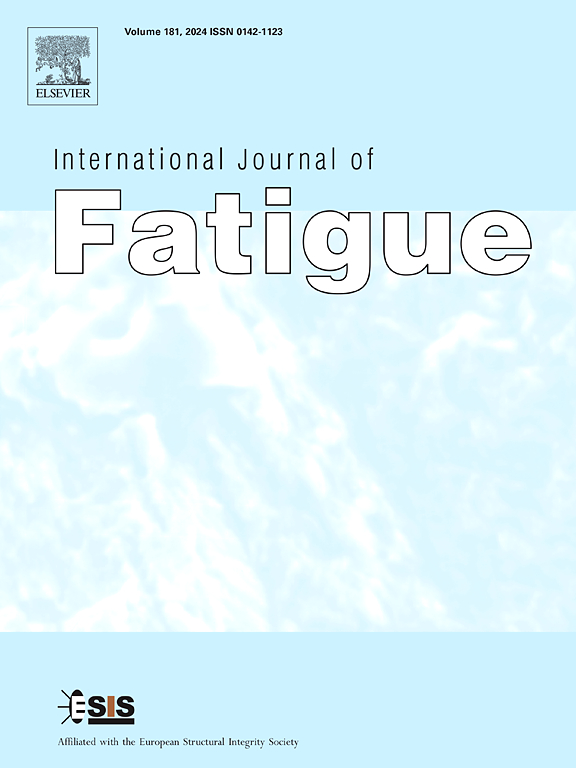螺栓预紧不确定性对考虑强制装配相互作用的单搭沉头复合螺栓连接疲劳可靠性的影响
IF 5.7
2区 材料科学
Q1 ENGINEERING, MECHANICAL
引用次数: 0
摘要
螺栓预紧力是保证复合螺栓连接安全性的关键。飞机装配过程中螺栓实际预紧力水平波动较大,影响了接头的疲劳可靠性。复合材料机体配合面普遍存在装配间隙,在施加螺栓预紧力前进行强制装配是消除装配间隙的常用方法,这种方法会导致螺栓头疲劳开裂,削弱接头的疲劳性能。在本研究中,系统地评估了螺栓预紧不确定性对考虑强制装配相互作用的单搭接沉头复合螺栓连接疲劳可靠性的影响。建立了渐进疲劳损伤模型(PFDE)和扩展有限元法(XFEM)相结合的方法,分别对孔轴承损伤和螺栓头疲劳开裂进行了表征。结果表明:在70% Fxbro(2%)疲劳载荷水平下,螺栓头疲劳开裂,螺栓预紧力越大,强制组合接头的疲劳寿命越短;螺栓预紧力越高,螺栓头疲劳开裂发生越早,刚度退化越快,疲劳破坏越快。螺栓头裂纹尺寸随螺栓预紧力的增大呈增大趋势,导致接头残余强度降低。在70% Fxbro(2%)的疲劳载荷水平下,强制装配后的复合螺栓接头的疲劳寿命呈右偏斜分布,螺栓预载荷低于平均值时将引发螺栓头疲劳开裂。本文章由计算机程序翻译,如有差异,请以英文原文为准。
Effect of bolt preload uncertainty on fatigue reliability of single-lap, countersunk composite bolted joints considering forced assembly interaction
Bolt preload plays a crucial part in ensuring the security of composite bolted joints. The actual bolt preload level displays noticeable fluctuation during aircraft assembly, impacting the fatigue reliability of joints. Assembly gaps commonly arise at the mating surface of composite airframes, and forced assembly is a prevalent method for closing the gaps before applying bolt preload, which leads to the bolt head fatigue cracking, weakening the fatigue performance of joints. In this study, the effect of bolt preload uncertainty on fatigue reliability of single-lap, countersunk composite bolted joints considering forced assembly interaction was systematically evaluated. The combination of progressive fatigue damage model (PFDE) and extended finite element method (XFEM) was developed to characterize the hole bearing damage and the bolt head fatigue cracking respectively. The findings show that the joints with forced assembly present a shorter fatigue life with increasing bolt preload under the fatigue load level of 70% due to bolt head fatigue cracking. Higher bolt preload makes the bolt head fatigue cracking occur earlier, thus stiffness degrades and fatigue failure more rapidly. The bolt head crack size shows a growing trend with increased bolt preload, leading to a lower residual strength of joints. With a Gaussian distribution of actual bolt preload, the composite bolted joints after forced assembly presents a right-skewed distribution fatigue life under the fatigue load level of 70% , since the bolt head fatigue cracking would be triggered at a bolt preload lower than the mean value.
求助全文
通过发布文献求助,成功后即可免费获取论文全文。
去求助
来源期刊

International Journal of Fatigue
工程技术-材料科学:综合
CiteScore
10.70
自引率
21.70%
发文量
619
审稿时长
58 days
期刊介绍:
Typical subjects discussed in International Journal of Fatigue address:
Novel fatigue testing and characterization methods (new kinds of fatigue tests, critical evaluation of existing methods, in situ measurement of fatigue degradation, non-contact field measurements)
Multiaxial fatigue and complex loading effects of materials and structures, exploring state-of-the-art concepts in degradation under cyclic loading
Fatigue in the very high cycle regime, including failure mode transitions from surface to subsurface, effects of surface treatment, processing, and loading conditions
Modeling (including degradation processes and related driving forces, multiscale/multi-resolution methods, computational hierarchical and concurrent methods for coupled component and material responses, novel methods for notch root analysis, fracture mechanics, damage mechanics, crack growth kinetics, life prediction and durability, and prediction of stochastic fatigue behavior reflecting microstructure and service conditions)
Models for early stages of fatigue crack formation and growth that explicitly consider microstructure and relevant materials science aspects
Understanding the influence or manufacturing and processing route on fatigue degradation, and embedding this understanding in more predictive schemes for mitigation and design against fatigue
Prognosis and damage state awareness (including sensors, monitoring, methodology, interactive control, accelerated methods, data interpretation)
Applications of technologies associated with fatigue and their implications for structural integrity and reliability. This includes issues related to design, operation and maintenance, i.e., life cycle engineering
Smart materials and structures that can sense and mitigate fatigue degradation
Fatigue of devices and structures at small scales, including effects of process route and surfaces/interfaces.
 求助内容:
求助内容: 应助结果提醒方式:
应助结果提醒方式:


